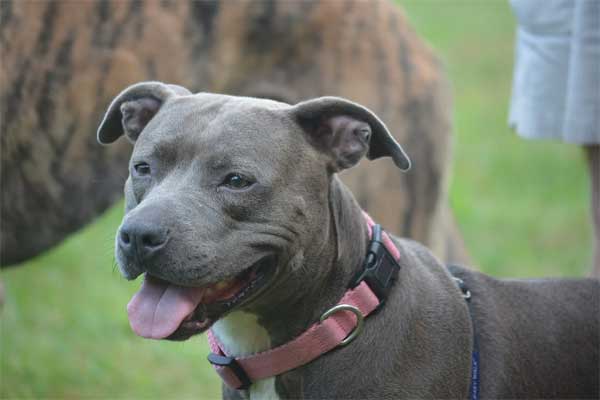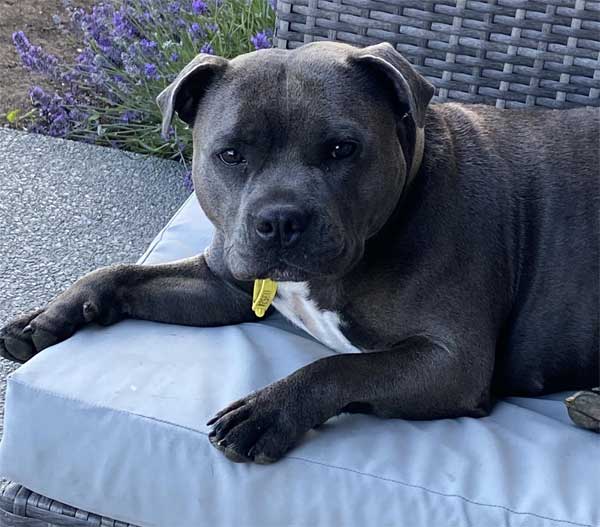Blue nose staffy
Amidst the pantheon of canine companions, the Blue Nose Staffordshire Bull Terrier, commonly known as the Blue Nose Staffy, emerges as a breed cloaked in both mystique and charm. With their distinctive coloring and endearing temperament, Blue Nose Staffys have garnered a loyal following. This article delves into the heart of what makes these dogs such a beloved breed, examining their origins, characteristics, and the essentials of responsible ownership and breeding.
Unveiling the Blue Nose Staffy
Table of Contents

The Blue Nose Staffy is not a distinct breed, but rather a Staffordshire Bull Terrier with a unique blue-gray hue to their coat, nose, eyes, and toenails. This coloring is the result of a recessive gene that dilutes the typical black pigment. Despite the name, their nose isn’t always blue; it can vary from a slate gray to a shade resembling charcoal. A Blue Nose Staffy’s allure isn’t skin deep – these dogs are renowned for their robust build, affectionate nature, and courageous spirit.
Though they share the ‘Staffy’ moniker with the American Staffordshire Terrier, they are a breed apart, with their own distinct lineage. This variant of the Staffordshire Bull Terrier stands out not only for its color but for its rarity. The blue coloration is less common than the traditional brindle or other solid colors found in the breed. Enthusiasts are often drawn to them for their striking appearance and the novelty of owning a less common type of Staffy.
Breed Origins and History

Staffordshire Bull Terriers hail from the Staffordshire region of England, where they were originally bred in the 19th century. The Blue Nose Staffy shares this heritage. The breed’s ancestors were the product of crossing the Bulldog with the now-extinct English White Terrier to create a dog that was both agile and strong, suited for the unfortunate practice of bull-baiting and later, dog fighting.
With the outlawing of these blood sports, the breed’s inherent qualities of courage and tenacity were redirected. Breeders began to emphasize traits such as loyalty, friendliness, and an affinity towards human companionship, which made them excellent family pets. Today’s Staffordshire Bull Terriers, including Blue Nose Staffys, are cherished for these companionable traits and are a testament to how selective breeding can reshape a breed’s reputation and purpose.
Key Characteristics Explained

The Blue Nose Staffy is a dog of many virtues:
- Appearance: They possess a muscular build, a broad head, and a short muzzle. Their coat is short and smooth, and their distinctive blue nose accompanies their blue-tinted coat.
- Temperament: Known for their intelligence and affection, they are eager to please and form strong bonds with their families. They are typically friendly with both humans and other dogs.
- Size and Lifespan: Males and females stand at 14 to 16 inches and can weigh between 24 to 38 pounds, with a life expectancy of 12 to 14 years.
- Exercise Needs: They are an energetic breed that thrives with regular exercise, mental stimulation, and play.
- Socialization: Early socialization is crucial to prevent any potential aggression, especially given their strong-willed nature.
- Adaptability: They are adaptable to various living situations, but they do best in homes where they are not left alone for extended periods.
These characteristics make the Blue Nose Staffy a versatile and desirable companion for various individuals and families.
Health and Nutrition Needs

Like all breeds, the Blue Nose Staffy has specific health and nutrition requirements to maintain its well-being. A balanced diet tailored to their age, size, and activity level is crucial. High-quality dog food, whether commercially manufactured or home-prepared with your vet’s supervision, will suffice. Keep an eye on their calorie consumption to prevent obesity, a common health problem.
Blue Nose Staffys are prone to certain genetic health issues, including skin allergies, cataracts, and hip dysplasia. Regular veterinary check-ups can help catch and manage these conditions early. It’s also important to keep up with routine vaccinations, flea, tick, and worm prevention, and dental care to ensure a long and healthy life.
Exercise is vital for the physical health and mental well-being of any Staffy. Adequate daily exercise helps to prevent behavior problems and supports muscle and joint health. Remember that the blue coloration is associated with a skin condition called Color Dilution Alopecia, which may require special dermatological care to manage any skin sensitivity or hair loss.
Training Tips for Your Staffy

The intelligence and eager-to-please nature of the Blue Nose Staffy make them a joy to train, but they do require consistent, firm guidance. Here are several key training tips:
- Start Early: Begin training and socialization as early as possible to take advantage of their formative puppy months.
- Positive Reinforcement: Use positive reinforcement techniques such as treats, praise, and play to encourage desired behaviors.
- Consistency is Key: Keep training sessions consistent in time, voice commands, and expectations to avoid confusion.
- Patience and Persistence: Staffys can be stubborn at times, so patience and persistence are essential in training.
- Set Boundaries: Establish clear boundaries and rules for your dog to follow within your home and during walks.
- Professional Assistance: Don’t hesitate to seek professional training classes or the assistance of a certified dog trainer, especially if you’re a first-time owner.
With the right approach, your Blue Nose Staffy can be a well-mannered and disciplined companion.
Finding a Reputable Breeder

When looking to bring a Blue Nose Staffy into your home, it’s critical to find a reputable breeder who prioritizes the health and well-being of their dogs. Here are some indicators that you’re dealing with a responsible breeder:
- They provide a clean, safe environment for their dogs and puppies.
- They willingly offer health clearances and genetic testing results for both puppy and parents.
- They allow you to meet the puppy’s parents and siblings.
- They ask you questions to ensure you’re a good match for their puppy.
- They have a thorough knowledge of the breed and openly discuss its pros and cons.
- They provide guidance on care, nutrition, and training for your new pup.
A reputable brearer is imperative for finding a healthy, well-socialized Staffy that will thrive in your family for years to come.
Comparison Table: Blue Nose Staffy vs. Traditional Staffy
| Aspect | Blue Nose Staffy | Traditional Staffy |
|---|---|---|
| Color | Blue-gray coat, nose, and eyes | Brindle, fawn, white, black, or red; black nose |
| Rarity | Less common due to recessive gene | More common color variations |
| Health Concerns | Potential for Color Dilution Alopecia | Typical breed health concerns without the dilute gene |
| Price | Often higher due to rarity | Generally lower than Blue Nose Staffys |
| Temperament | Intelligent, affectionate, energetic | Similar traits—breed standard temperament |
| Popularity | Sought after for unique coloring | Well-established popularity within the breed |
This comparison table highlights the main differences between the Blue Nose Staffy and traditional color variations within the Staffordshire Bull Terrier breed.
The Blue Nose Staffy stands out as a sterling example of the Staffordshire Bull Terrier breed, drawing admirers with its unique color and winning hearts with its affectionate personality. Understanding the breed’s history, characteristics, health, and training needs ensures that these dogs not only capture our imaginations but also receive the care they deserve. As with any breed, responsible breeding and ownership are paramount. For those captivated by the Blue Nose Staffy’s charm, finding a reputable breeder and committing to proper training and care can lead to a loving and fulfilling relationship with a truly special canine companion.



